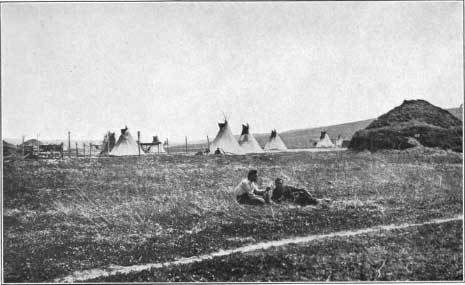Omaha Tribe – Omaha Indians (‘those going against the wind or current’ ). One of the 5 tribes of the so called Dhegiha group of the Siouan family, the other 4 being the Kansa, Quapaw, Osage, and Ponca. Hale and Dorsey concluded from a study of the languages and traditions that, in the westward migration of the Dhegiha from their seat on Ohio and Wabash rivers after the separation, at least as early as 1500, of the Quapaw, who went down the Mississippi from the mouth of the Ohio, the Omaha branch moved up the great river, remaining awhile near the mouth of the Missouri while war and hunting parties explored the country to the northwest. The Osage remained on Osage river and the Kansa continued up the Missouri, while the Omaha, still including the Ponca, crossed the latter stream and remained for a period in Iowa, ranging as far as the Pipestone quarry at the present Pipestone, Minnesota. They were driven back by the Dakota, and after the separation of the Ponca, who advanced into the Black Hills, which occurred probably about 1650 at the mouth of Niobrara river, the Omaha settled on Bow creek, Nebraska, and may have already been there at the date of Marquette’s map (1673). Jefferys (1761) located the Omaha on the east side of Missouri river, beyond the Iowa, immediately above Big Sioux river. In 1766 they appear to have had friendly relations with the Dakota, as Carver mentions having met both tribes together on Minnesota river. They were at their favorite resort near Omadi, Dakota county, Nebraska, in 1800. Lewis and Clark (1804) found them on the south side of Missouri River opposite Sioux City, South Dakota, but learned that the tribe in 1802, while living at a point farther up the Missouri, was visited by smallpox, which had greatly reduced their number and caused their removal. Then, as in later years they were at constant war with the Sioux. They were on the west side of the Missouri a short distance above the Platte in 1845, but in 1855 removed to what is now Dakota county, Nebraska. They joined with other tribes in the treaties of July 15, 1830, and Oct. 15, 1836, and by the treaty of Washington, D. C., Mar. 16, 1854, ceded all their lands west of the Missouri and south of a line running due west from the point where Iowa river leaves the bluffs, retaining their lands north of this line for a reservation. By treaty of Mar. 6, 1865, they sold part of their reservation to the United States for the use of the Winnebago. Many of them learned to cultivate grain and raise stock, and in 1882, through the effort of Miss Alice C. Fletcher, a law was enacted granting lands in severalty and prospective citizenship.

The primitive dwellings of the Omaha were chiefly lodges of earth, more rarely of bark or mats, and skin tents. The earth lodges, similar in construction to those of the Mandan, were intended principally for summer use, when the people were not hunting. The bark lodges were usually elliptical in form, occasionally having two fireplaces and two smoke holes. The skin tent was used when the people were traveling or hunting the buffalo. Pottery was made by the Omaha before 1850, but the art has been forgotten. Their mortars were made by burning a hollow in a knot or round piece of wood, and spoons were made of horn, wood, and pottery. Polygamy was practiced, but the maximum number of wives that any one man could have was three.
Until 1880 there were two principal chiefs, usually selected from the Hangashenu subtribe, though there was no law or rule forbidding their selection from other divisions. In addition to these there were subordinate chiefs. Their religion, according to Dorsey 1 , was associated with the practice of medicine, mythology, and war customs, and with their gentile system.
The population of the Omaha since their recovery from the great loss by smallpox in 1802, when they were reduced to about 300, has greatly increased. In 1804, according to Lewis 2 , they numbered 600, including 150 warriors. In 1829 they were estimated at 1,900, and in 1843 at 1,600, both of which estimates were probably excessive. Schoolcraft gives 1,349 in 1851, Burrows 1,200 in 1857, and the same number is given by the census of 1880. In 1906 the population of the tribe was 1,228.
Citations:



4.5